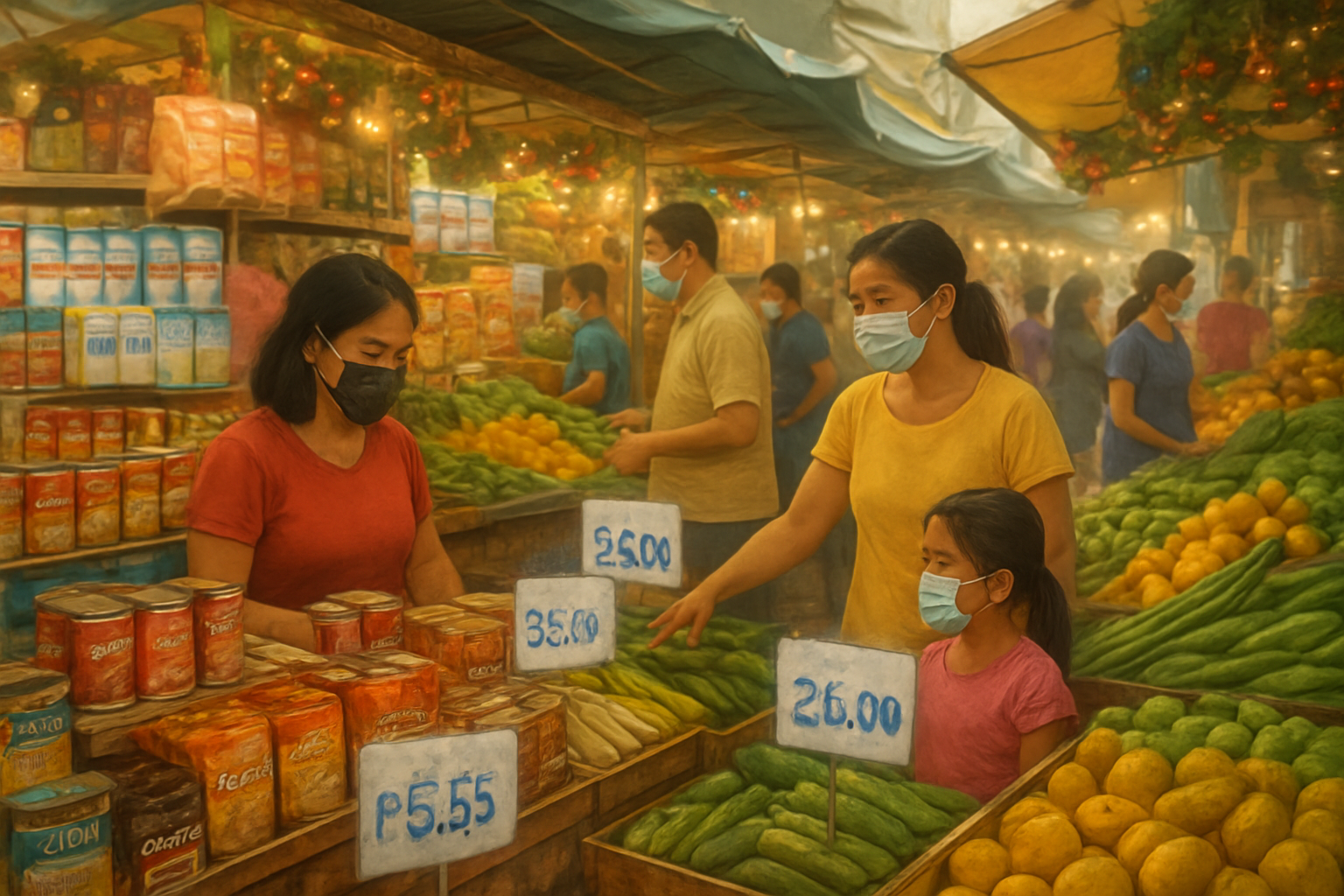
MANILA, Philippines – In a decisive move aimed at protecting Filipino consumers during the bustling holiday season, President Ferdinand “Bongbong” Marcos Jr. has ordered a nationwide price freeze on basic and prime commodities, effective immediately. Announced on October 27, 2025, this government directive is set to keep essential goods affordable until the end of the year, potentially offering significant relief to households grappling with inflationary pressures.
The immediate implications of this order are far-reaching, promising a period of price stability for a wide array of necessities as families prepare for Christmas and New Year celebrations. While consumers are likely to welcome the measure as a much-needed reprieve, producers and retailers face the challenge of maintaining margins amidst potentially rising operational costs, setting the stage for a dynamic interplay between market forces and government intervention.
Government Steps In: Details of the Holiday Price Moratorium
President Marcos Jr. issued the directive on Monday, October 27, 2025, just before his departure for the 47th ASEAN Summit in Kuala Lumpur, signaling the administration's proactive stance on economic stability. The price freeze, which is now in effect, will remain until December 31, 2025, covering the entire duration of the holiday festivities. This move builds on previous efforts by the administration to manage inflation, including earlier tariff reductions on imported rice.
The extensive list of commodities under the price freeze includes vital household staples such as canned sardines, canned meats, all types of milk, coffee, bottled water, instant noodles, bread, salt, soy sauce, fish sauce, vinegar, and candles. The Department of Trade and Industry (DTI), under the leadership of Secretary Ma. Cristina Aldeguer-Roque, has been tasked with the stringent monitoring and enforcement of this order, ensuring that maximum suggested retail prices (SRPs) for these items, including imported rice, are strictly adhered to across the archipelago.
The primary rationale behind this intervention is to safeguard consumers from speculative price hikes that often accompany increased demand during the holiday season. The government emphasizes its commitment to shielding Filipinos from the burden of high food prices and ensuring that inflation remains within manageable targets. Initial reactions from government agencies indicate a concerted effort to collaborate with industry stakeholders. Producers and manufacturers have reportedly agreed in principle to halt price increases until the end of the year, with some even expressing willingness to extend this stability into early 2026, drawing parallels to a similar voluntary price freeze observed in June 2024. Consumers, though not immediately polled for this specific freeze, generally view such measures favorably, anticipating a more budget-friendly holiday shopping experience.
Navigating the Freeze: Winners and Losers in the Market
The nationwide price freeze presents a mixed bag of fortunes for public companies operating in the Philippine basic and prime commodities sector. While the directive aims to benefit consumers, it introduces a period of constrained pricing power for manufacturers and distributors.
Major conglomerates with significant exposure to the covered commodities will be directly impacted. San Miguel Corporation (PSE: SMC) and its food arm, San Miguel Food and Beverage, Inc. (PSE: SMFB), are key players. SMFB produces a wide range of products including canned meats (e.g., Purefoods, Star Corned Beef) and coffee (San Mig Coffee), which fall under the freeze. These companies might experience a squeeze on their profit margins if their input costs (raw materials, logistics, labor) continue to rise while selling prices remain capped. However, their diversified portfolios and economies of scale might offer some buffer against severe impacts.
Similarly, Monde Nissin Corporation (PSE: MONDE), a titan in the instant noodle market with its popular Lucky Me! brand, will operate under the price ceiling. Century Pacific Food Inc. (PSE: CNPF), a leader in canned goods like sardines and other processed meats, will also face the same pricing restrictions. Universal Robina Corporation (PSE: URC), known for its coffee, biscuits, and snack items, will also see a portion of its product lineup affected. These companies, while demonstrating social responsibility by adhering to the freeze, will need to be agile in managing their cost structures to mitigate potential earnings dilution.
On the consumer side, retailers, particularly large supermarket chains and grocery stores, might see increased foot traffic and sales volume as consumers feel more confident about stable prices. However, their margins on affected goods will also be fixed, potentially shifting their focus to higher-margin non-frozen items or private-label brands. Smaller retailers and sari-sari stores, which often operate on thinner margins, might find it challenging to absorb any increases in wholesale costs without passing them on, though the DTI's monitoring should theoretically prevent such occurrences. The "winners" in this scenario are predominantly the consumers, who gain purchasing power and budget predictability during a traditionally expensive time of the year.
Broader Strokes: Significance and Historical Context
President Marcos Jr.'s price freeze order is not an isolated event but rather fits into a broader global and domestic trend of governments intervening in markets to combat inflation and protect vulnerable populations. In an era marked by supply chain disruptions, geopolitical tensions, and climate change impacts, commodity prices have shown significant volatility, prompting various nations to implement price controls, subsidies, or export bans. This directive aligns with the Philippine government's consistent efforts to stabilize food prices, following previous measures like lowering tariffs on imported rice to increase supply and ease consumer burden.
The potential ripple effects of this freeze extend beyond the immediate producers. Suppliers of raw materials, packaging, and logistics services to these commodity manufacturers might face pressure to keep their costs stable, as their clients' ability to absorb price increases is curtailed. Competitors, both local and international, will closely watch the market dynamics. For instance, foreign brands or imported goods not explicitly covered by the SRPs might see a competitive advantage or disadvantage depending on how their pricing aligns with the frozen local goods.
Regulatory and policy implications are also significant. The DTI's enhanced monitoring role underscores the government's commitment to enforcement, potentially setting a precedent for future interventions during periods of economic strain. Historically, price freezes have had mixed results. While they offer short-term relief, prolonged or poorly managed controls can sometimes lead to supply shortages if producers find it uneconomical to continue production at capped prices, or if black markets emerge. However, the current freeze is explicitly temporary and targeted for a specific period, aiming to avoid such long-term distortions. Comparisons can be drawn to similar price freezes implemented during states of calamity or emergencies, where the government temporarily steps in to prevent profiteering.
The Road Ahead: Short-Term Relief, Long-Term Vigilance
In the short term, the holiday price freeze is expected to provide tangible relief for millions of Filipino households, ensuring that basic necessities remain accessible and affordable throughout the festive season. Consumers can anticipate more predictable spending on essential goods, which could indirectly boost spending in other sectors of the economy as discretionary income is freed up. For producers, the immediate focus will be on efficient inventory management, optimizing production costs, and potentially shifting promotional efforts towards non-frozen products or value-added offerings to maintain profitability.
Looking ahead into 2026, the lifting of the price freeze will be a critical juncture. Manufacturers might then adjust prices to reflect accumulated cost increases, potentially leading to a surge in prices post-freeze. This could present a challenge for policymakers who will need to carefully manage expectations and implement strategies to prevent a sharp rebound in inflation. Strategic pivots for companies might include diversifying their supply chains to mitigate raw material price volatility, investing in cost-saving technologies, or exploring new product lines that offer better margin potential.
Market opportunities could emerge for innovative companies that can develop more cost-efficient production methods or alternative, affordable product formulations. Conversely, challenges will persist for those heavily reliant on imported raw materials, as global commodity price fluctuations remain a significant risk. Potential scenarios range from a smooth transition post-freeze, where price adjustments are gradual and absorbed by the market, to a more volatile period if underlying inflationary pressures persist. The government will likely continue its vigilance, possibly exploring other non-price control mechanisms to ensure market stability in the long run.
Wrapping Up: A Festive Truce in the Price Wars
President Marcos Jr.'s nationwide holiday price freeze on basic and prime commodities represents a significant government intervention designed to offer a festive truce in the ongoing battle against inflation. The key takeaway is the government's firm commitment to consumer protection during a crucial period of high demand. While offering immediate relief to consumers, the directive places a temporary constraint on the pricing power and potentially the profit margins of major food and beverage companies like San Miguel Food and Beverage, Inc. (PSE: SMFB), Monde Nissin Corporation (PSE: MONDE), Century Pacific Food Inc. (PSE: CNPF), and Universal Robina Corporation (PSE: URC).
Moving forward, the market will assess how effectively the DTI enforces the freeze and how producers adapt to the fixed price environment. Investors should closely watch the financial reports of affected public companies for any indications of margin compression or changes in sales volume for frozen versus non-frozen goods. The period immediately following the lifting of the freeze in early 2026 will also be crucial, as companies may attempt to recalibrate prices.
Ultimately, the lasting impact of this order will be measured not only by the immediate consumer relief it provides but also by its influence on industry behavior and the government's broader inflation management strategy. It underscores the delicate balance policymakers must strike between supporting consumer welfare and maintaining a healthy, competitive market environment.
This content is intended for informational purposes only and is not financial advice





